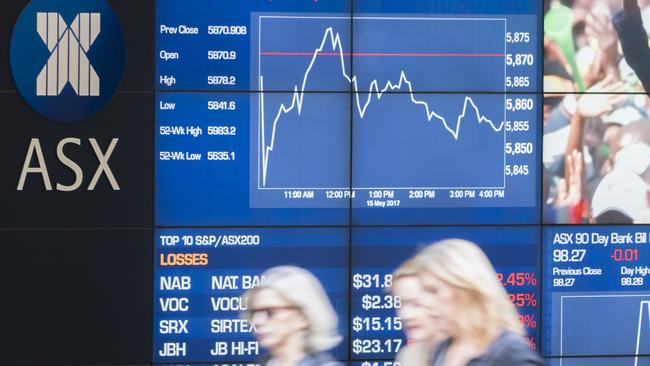Keep an eye on this sign that global investments may sour
A key economic indicator that tends to go south before every global economic downturn has just gone south again. David and Libby Koch reveal why the outlook is souring, and whether the trend can be reversed.
Saver HQ
Don't miss out on the headlines from Saver HQ. Followed categories will be added to My News.
It’s the canary of the health of the global economy. The early warning signal of a possible economic meltdown, and it’s currently chirping pretty loudly.
It’s called the inverted yield curve … weird name but crushingly powerful consequences.
Under normal investment and economic logic, the longer you invest money the higher return you should receive because you’re tying your money up for longer.
So the interest return on short-term government bonds is generally lower than investing in longer term bonds.
An inverted yield curve is the opposite.
It’s when short-term government bond yields (interest rates) are higher than long term bond yields.
MORE: Kochie explains how to put your super on the right path
MORE: Kochie's take on the federal budget
What it indicates is that financial markets expect interest rates to fall in the future … and the only reason they would predict that happening is because they believe economies will slow significantly in the future and central banks will have to cut interest rates to stimulate.
An inverted yield curve happened in 2007 just before the last Global Financial Crisis.
In fact in the US, an inverted yield curve has preceded all but one of their last seven recessions.
We’ll never forget getting a call from a friend at the height of the 2007 share boom telling us his wife (who worked in the financial markets) was making him sell every asset they owned because the bond markets were indicating an economic collapse.
It was the inverted yield curve.

At the time markets were booming around the world.
Investors were caught in a money-making hysteria believing this was the boom that would change the world forever, that the good times would never end.
Banks around the world were hosing money at customers and ignoring prudent lending practices to a point where borrowers were getting way over their head in debt.
That inverted yield curve was the precursor to the biggest financial and economic crash since the Great Depression.
Portugal, Italy, Greece and Spain basically went broke and defaulted on their loans, banks collapsed, the US went into a deep recession, unemployment skyrocketed, share prices and property values plunged … except here in Australia.
Through a combination of good management (in retrospect from the Labor Government as recently acknowledged by the prestigious Economist magazine) and luck (because of a booming China taking our exports) Australia sailed through this period relatively unscathed. But for the rest of the world it was an ugly period of misery for millions of people.
So when there is an inverted yield curve it is important to take notice and be aware. In the GFC, it was bank lending practices and countries defaulting on their loans that sparked the crash.
So what could be the triggers that are spooking the economic canary today?
CHINA-US TRADE WAR
The world’s two biggest economies and trading nations are in a war of words, threatening to sanction each other with higher tariffs and scaring everyone else.
China is America’s banker as it owns the largest slice of US debt.
America is China’s biggest customer.
If these two superpowers fall out of favour the ripple effect will be enormous.
The latest word is negotiations for a trade deal are going well but they are still ongoing and nothing definite is agreed. That uncertainty is spooking markets.
GLOBAL PROTECTIONISM
If China and US don’t agree a new trade deal the fear is the rest of the world will be dragged into the dispute and forced to take sides.
The concern is that US allies, of which we’re one, will be ostracised by the Chinese and face similar sanctions.
As China is Australia’s biggest customer, accounting for a third of our total exports, any sort of disruption to our current trading environment could be devastating for our economy.
The Chinese could just as easily shift their buying to one of their own allies that is part of the Belt and Road trading initiative.
History tells us that protectionism is bad for trade and bad for the global economy.
DIGITAL DISRUPTION
Every industry is being disrupted by digital businesses and it’s changing the way companies operate.
Online shopping is the most obvious example, with a devastating impact on traditional bricks and mortar retailers that haven’t changed their business model to compete.
This threat (and opportunity) is being replicated across virtually every industry.
It is leading to massive job losses in businesses that don’t change but adding huge numbers of jobs to businesses which are adapting.
The uncertainty of who will win and who will lose from this disruption is spooking markets.

BREXIT
Britain’s exit from the European Union is nothing short of shambolic. It’s embarrassing.
The Brits still can’t agree on a plan for the future even though their referendum instructions from the public were pretty clear.
Plus the Europeans are getting increasingly annoyed at the lack of clear plan.
The fear is that Britain’s exit could provide a blueprint for other countries to follow and potentially lead to the destruction of the world’s most powerful trading bloc.
That uncertainty is adding to concerns about economic growth in the region.
These four factors need watching closely.
You’ll notice the common use of the word “uncertain”.
Markets hate uncertainty, and they hate surprises because it makes planning difficult.
The inverted yield curve is reflecting that uncertainty.
Resolution of any of these let factors can just as easily quickly turn sentiment.


